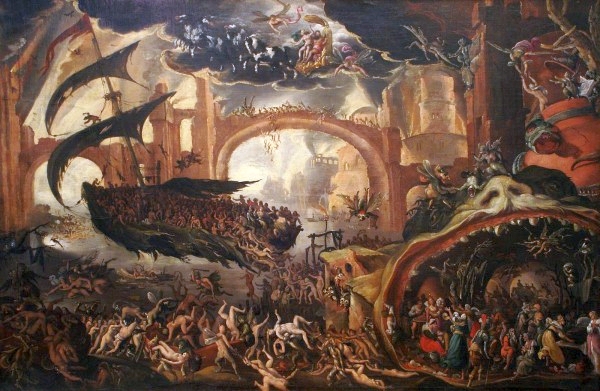Note: If you wish to receive, via e-mail, (1) my weekly newsletter or (2) daily copies of these posts, notify me at rrbates1951@gmail.com and indicate which you would like. I promise not to share your e-mail address with anyone. To unsubscribe, send me a follow-up email.
Tuesday – Halloween
For Halloween, I share this passage from Virgil’s Aeneid (trans. Robert Fagles). At the entrance of the underworld, Aeneas must muster up all his courage to make his way through a swarm of horrors. If you are one who dresses up for Halloween, you might find some ideas here.
The Trojan leader is on his way to query his recently deceased father about what he should do next. (Answer: Conquer the Latins and kickstart the Roman Empire.) The Cunaean sybil, who presides over Apollo’s oracle in Naples, is his guide. Before reaching the door of the underworld, they must walk through gloomy darkness, just as we did as kids:
On they went, those dim travelers under the lonely night,
through gloom and the empty halls of Death’s ghostly realm,
like those who walk through woods by a grudging moon’s
deceptive light when Jove has plunged the sky in dark
and the black night drains all color from the world.
Unlike trick-or-treaters, it is the monsters who are at the door. They are plenty frightening:
There in the entryway, the gorge of hell itself,
Grief and the pangs of Conscience make their beds,
and fatal pale Disease lives there, and bleak Old Age,
Dread and Hunger, seductress to crime, and grinding Poverty,
all, terrible shapes to see—and Death and deadly Struggle
and Sleep, twin brother of Death, and twisted, wicked Joys
and facing them at the threshold, War, rife with death,
and the Furies’ iron chambers, and mad, raging Strife
whose blood-stained headbands knot her snaky locks.
There in the midst, a giant shadowy elm tree spreads
her ancient branching arms, home, they say, to swarms
of false dreams, one clinging tight under each leaf.
And a throng of monsters too—what brutal forms
are stabled at the gates—Centaurs, mongrel Scyllas,
part women, part beasts, and hundred-handed Briareus
and the savage Hydra of Lerna, that hissing horror,
the Chimaera armed with torches—Gorgons, Harpies
and triple-bodied Geryon, his great ghost. And here,
instantly struck with terror, Aeneas grips his sword
and offers its naked edge against them as they come,
and if his experienced comrade had not warned him
they are mere disembodied creatures, flimsy
will-o’-the-wisps that flit like living forms,
he would have rushed them all,
slashed through empty phantoms with his blade.
You could also choose to go to your Halloween party as Charon, the boatman who takes the dead across the River Styx:
And here the dreaded ferryman guards the flood,
grisly in his squalor—Charon . . .
his scraggly beard a tangled mat of white, his eyes
fixed in a fiery stare, and his grimy rags hang down
from his shoulders by a knot. But all on his own
he punts his craft with a pole and hoists sail
as he ferries the dead souls in his rust-red skiff.
One sees where Dante got his ideas for The Inferno. And why Virgil functions as his guide.


